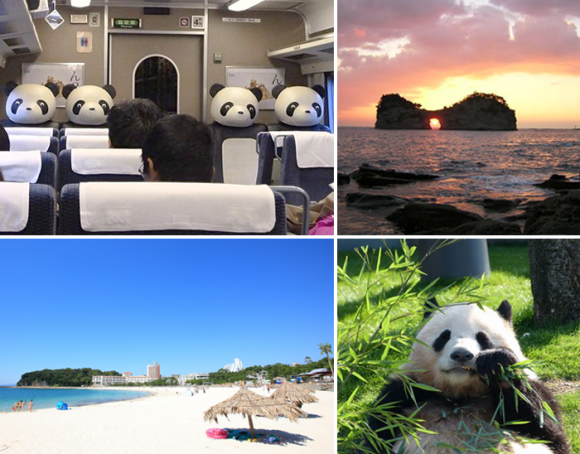
Though the “Panda Train” that runs between Kyōto and the beach resort town of Shirahama in Wakayama Prefecture has been around for a few years, Japanese netizens recently have been making quite the hubbub over photos of its panda seats. Online reactions range from “Kawaiiii!” to “It looks like it’ll hug me to death!”, but most agree that they’re simply confused by the presence of polyurethane pandas on a train heading to a former honeymoon Mecca.
While Shirahama (lit. “White Beach”) is famous for its beautiful sand, hot springs, and remarkable rock formations, many in Japan are surprisingly unaware of its other claim to fame: pandas. Read on to learn more about the crowd-pleasing train and a theme park complex called Adventure World, which has a panda-breeding and research facility with an impressive track record that’s second only to mainland China. If you’re already tired of the cold this winter, this article may give you some ideas for next summer!
From oldest to newest, the “Kuroshio”, “Super Kuroshio”, and “Ocean Arrow” are the three limited express trains that run between Kyōto and Nanki-Shirahama (南紀白浜), so called because it lies on the southern end of the Kī (紀伊) Peninsula and to avoid confusion with Izu-Shirahama in Shizuoka Prefecture. The one dubbed “Panda Train” is actually the Kuroshio, which means “black tide” and is named after the ocean current that carries warm water from the south as it flows past the eastern side of Japan.
▼ “Welcome to the Panda Train” — a handy poster for confused travelers!
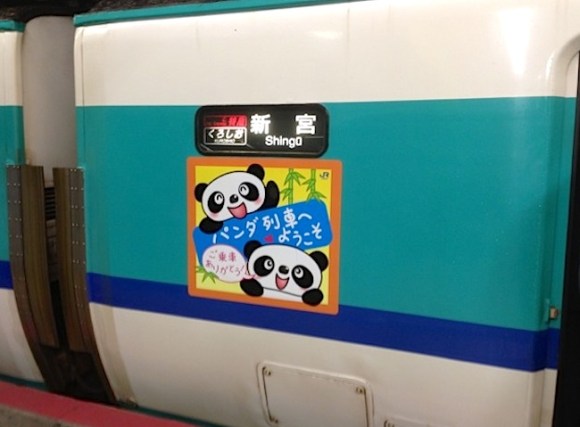
▼ Eyes… eyes everywhere…
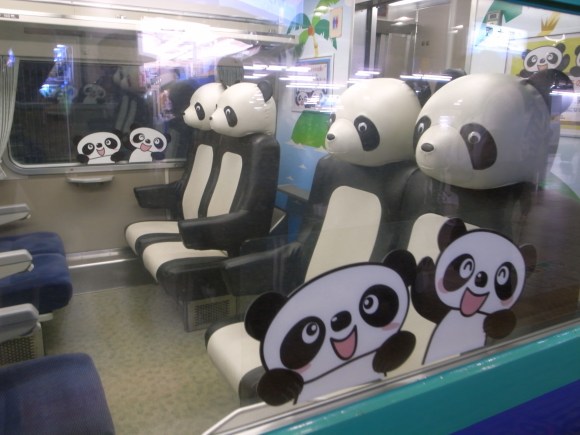
The ride from Ōsaka to Shirahama/Shingū Station aboard the Kuroshio is a reasonable two and a half hours. There are only four of the special panda seats on the entire train and though they’re placed in car #4’s reserved seating section, these seats are open to all.
Despite the online cries of “They won’t stop staring!” and “I wouldn’t be able to relax”, the googly-eyed seats with their Mona Lisa smile are extremely popular; proper etiquette is to not stay in them for too long once you’re finished taking photos. The limited express Kuroshio doesn’t always install the seats though, so one website recommended contacting the station ahead of time.
▼ On the poster in the back, a panda named Wakapan (derived from Wakayama and panda) says: “Please be nice and take turns. It’s everyone’s panda seat.”
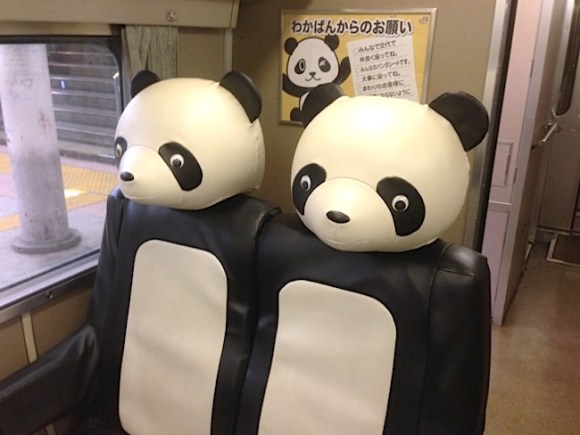
▼ They kind of remind me of the black-suited henchmen from The Triplets of Belleville…
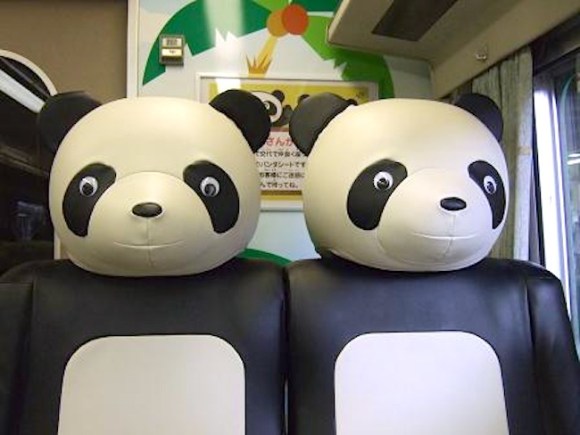
Once you reach Shirahama Station you’ll be greeted by, yup, panda statues! In fact, panda-themed sculptures and goods can be found all around town thanks to Shirahama’s Adventure World—an aquarium, safari park, and amusement park all in one. Though the Ueno Zoo in Tokyo tends to hog all the panda glory, in actuality Adventure World is currently the facility with the largest population of resident giant pandas in Japan, numbering at five. Not only that, its breeding center has successfully birthed and reared 12 pandas so far, including two sets of hard-to-raise twins, making it the most flourishing center in the world outside of mainland China.
▼ Say hello to… Rauhin? Yōhin? Rin Rin from Polar Bear Café would be able to tell the difference.
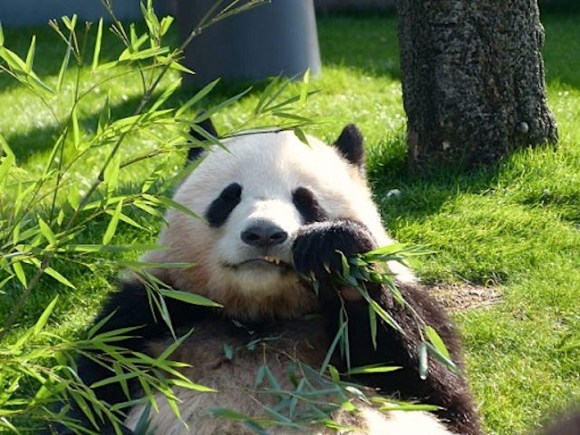
Residing in the breeding center are Chinese-born father Eimei (永明) and mother Rauhin (良浜, signifying “nice beach”), who was born in Shirahama 14 years ago. Twins Kaihin (海浜, “seashore”) and Yōhin (陽浜, “sunny beach”) were born at the center in 2010 and now live in an area of the park called Panda Love, along with Yūhin (優浜, “gentle beach”) who was born in August 2012. And as you may have noticed, the “-hin” in the pandas’ names is the same kanji character as the “-hama” in Shirahama. If you want to be bombarded by cuteness, scroll to the bottom half of this official Japanese page and click on the photo gallery link for each roly-poly resident; there are pictures from birth to present day!
▼ Little Kaihin pestering mom Rauhin during mealtime at Panda Love.
▼ Watch as protective Rauhin hugs baby Yūhin at the end!
If you’ve had your fill of safari rides and dolphin shows, then head to Shirara-hama (Shirara Beach), which has been enjoying a Goodwill Beach City relationship with Waikīkī Beach since 2000. Like most beaches, though, this one is crowded in the summer so locals and those in the know prefer to visit during the off-season.
▼ A view of Shirara-hama.
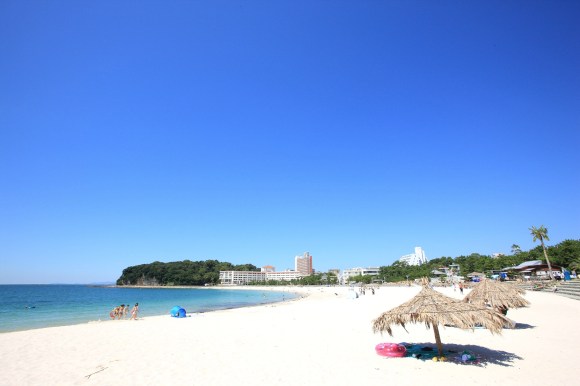
▼ To augment the shoreline that had been shrinking due to erosion and urban development, white sand similar to the original has been imported from Australia since 1989.
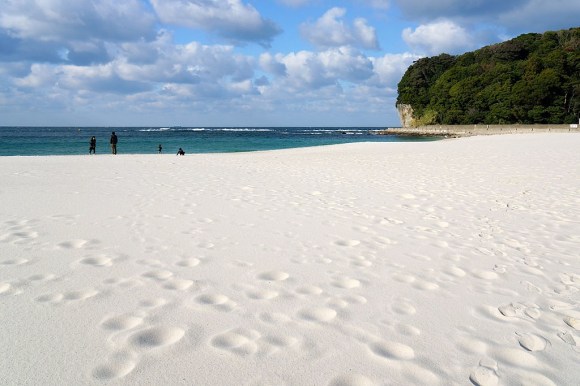
Other popular nearby sites include the Sandanbeki (meaning “three step cliff”) and Engetsu-tō (“round moon island”), a natural arch that was created by marine erosion.
▼ A view of Sandanbeki, which is thought to have been a lookout post for schools of fish.
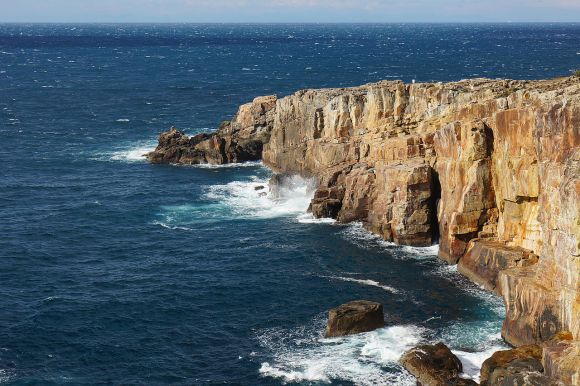
▼ Pirates from the Heian period called the Kumano Kaigun are said to have lived in its caverns.
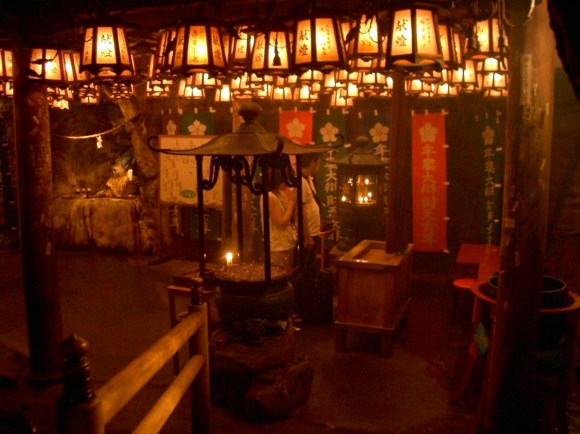
▼ Takashima, commonly called Engetsu-tō because of its eye-catching form, is a popular place to watch the sun set.
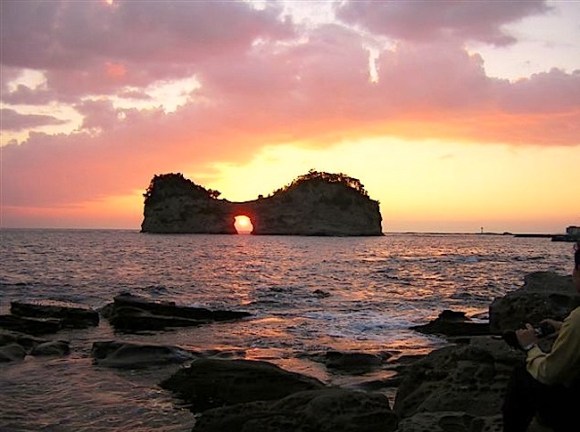
If this has inspired you to hop aboard the Kuroshio train before going on a panda- and nature-filled romp through southern Wakayama, some useful information can be found on Adventure World’s English site as well as the West Japan Railway Company’s travel page. Already been there? Share your experiences with fellow readers in the comments section!
Sources: Hamster Sokuhou, goo Blog 1, JR Odekake Net, Wikipedia 1, 2, 3, Adventure World, Nanki-Shirahama Kankou Guide, Kinan Jouhou Station
Feature Images: Twitter, Hiro-chan no Photo Gallery, All Shirahama, goo Blog 2
Videos: YouTube 1, 2
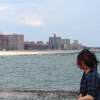
 Teeny tiny giant panda baby born in Japan【Photos】
Teeny tiny giant panda baby born in Japan【Photos】 Popular Japanese treat Tokyo Banana gets special makeover for baby panda’s debut at Ueno Zoo
Popular Japanese treat Tokyo Banana gets special makeover for baby panda’s debut at Ueno Zoo China’s first suspended railway looks like a panda soaring through the skies
China’s first suspended railway looks like a panda soaring through the skies A calendar filled with pictures of furry panda butts is here to improve your gloomy Mondays
A calendar filled with pictures of furry panda butts is here to improve your gloomy Mondays Ueno Park’s panda bread is just as warm, fluffy and cute as the pandas themselves 【Photos】
Ueno Park’s panda bread is just as warm, fluffy and cute as the pandas themselves 【Photos】 Disney princesses get official manga makeovers for Manga Princess Cafe opening in Tokyo
Disney princesses get official manga makeovers for Manga Princess Cafe opening in Tokyo Beautiful new Final Fantasy T-shirt collection on the way from Uniqlo【Photos】
Beautiful new Final Fantasy T-shirt collection on the way from Uniqlo【Photos】 Randomly running into a great sushi lunch like this is one of the best things about eating in Tokyo
Randomly running into a great sushi lunch like this is one of the best things about eating in Tokyo Is the new Shinkansen Train Desk ticket worth it?
Is the new Shinkansen Train Desk ticket worth it? Foreign English teachers in Japan pick their favorite Japanese-language phrases【Survey】
Foreign English teachers in Japan pick their favorite Japanese-language phrases【Survey】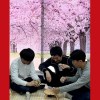 Sakura season schedule is screwed up, so we had a no-cherry blossom cherry blossom party in the office
Sakura season schedule is screwed up, so we had a no-cherry blossom cherry blossom party in the office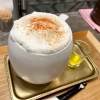 Cappuccino Ramen becomes super popular in Japan, but is it worth the hype?
Cappuccino Ramen becomes super popular in Japan, but is it worth the hype?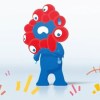 Osaka’s creepy cute mascot speaks for first time, adds more fuel the creepy OR cute debate【Video】
Osaka’s creepy cute mascot speaks for first time, adds more fuel the creepy OR cute debate【Video】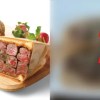 Is Japan’s massive Shizuoka steak sandwich really as delicious as it looks in promo photos?
Is Japan’s massive Shizuoka steak sandwich really as delicious as it looks in promo photos?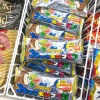 Kyushu-exclusive Black Mont Blanc goes nationwide in a “Special” way
Kyushu-exclusive Black Mont Blanc goes nationwide in a “Special” way We try out “Chan Ramen”, an underground type of ramen popular in the ramen community
We try out “Chan Ramen”, an underground type of ramen popular in the ramen community New Studio Ghibli bedding sets are cool in all senses of the word
New Studio Ghibli bedding sets are cool in all senses of the word Our Japanese reporter visits Costco in the U.S., finds super American and very Japanese things
Our Japanese reporter visits Costco in the U.S., finds super American and very Japanese things New Pokémon cakes let you eat your way through Pikachu and all the Eevee evolutions
New Pokémon cakes let you eat your way through Pikachu and all the Eevee evolutions There’s a park inside Japan where you can also see Japan inside the park
There’s a park inside Japan where you can also see Japan inside the park Japanese convenience store packs a whole bento into an onigiri rice ball
Japanese convenience store packs a whole bento into an onigiri rice ball Hanton rice — a delicious regional food even most Japanese people don’t know about, but more should
Hanton rice — a delicious regional food even most Japanese people don’t know about, but more should Final Fantasy, Kingdom Hearts, and Dragon Quest pet product line announced by Square Enix
Final Fantasy, Kingdom Hearts, and Dragon Quest pet product line announced by Square Enix Studio Ghibli releases Kiki’s Delivery Service chocolate cake pouches in Japan
Studio Ghibli releases Kiki’s Delivery Service chocolate cake pouches in Japan Japan’s bone-breaking and record-breaking roller coaster is permanently shutting down
Japan’s bone-breaking and record-breaking roller coaster is permanently shutting down New definition of “Japanese whiskey” goes into effect to prevent fakes from fooling overseas buyers
New definition of “Japanese whiskey” goes into effect to prevent fakes from fooling overseas buyers Foreign passenger shoves conductor on one of the last full runs for Japan’s Thunderbird train
Foreign passenger shoves conductor on one of the last full runs for Japan’s Thunderbird train Kyoto bans tourists from geisha alleys in Gion, with fines for those who don’t follow rules
Kyoto bans tourists from geisha alleys in Gion, with fines for those who don’t follow rules Studio Ghibli unveils Mother’s Day gift set that captures the love in My Neighbour Totoro
Studio Ghibli unveils Mother’s Day gift set that captures the love in My Neighbour Totoro Domino’s Japan now sells…pizza ears?
Domino’s Japan now sells…pizza ears? Toyota built a life-sized Miraidon Pokémon and are letting people test drive it this weekend
Toyota built a life-sized Miraidon Pokémon and are letting people test drive it this weekend New Japanese KitKat flavour stars Sanrio characters, including Hello Kitty
New Japanese KitKat flavour stars Sanrio characters, including Hello Kitty Sales of Japan’s most convenient train ticket/shopping payment cards suspended indefinitely
Sales of Japan’s most convenient train ticket/shopping payment cards suspended indefinitely Sold-out Studio Ghibli desktop humidifiers are back so Totoro can help you through the dry season
Sold-out Studio Ghibli desktop humidifiers are back so Totoro can help you through the dry season Japanese government to make first change to romanization spelling rules since the 1950s
Japanese government to make first change to romanization spelling rules since the 1950s Ghibli founders Toshio Suzuki and Hayao Miyazaki contribute to Japanese whisky Totoro label design
Ghibli founders Toshio Suzuki and Hayao Miyazaki contribute to Japanese whisky Totoro label design Doraemon found buried at sea as scene from 1993 anime becomes real life【Photos】
Doraemon found buried at sea as scene from 1993 anime becomes real life【Photos】 Tokyo’s most famous Starbucks is closed
Tokyo’s most famous Starbucks is closed One Piece characters’ nationalities revealed, but fans have mixed opinions
One Piece characters’ nationalities revealed, but fans have mixed opinions We asked a Uniqlo employee what four things we should buy and their suggestions didn’t disappoint
We asked a Uniqlo employee what four things we should buy and their suggestions didn’t disappoint Princesses, fruits, and blacksmiths: Study reveals the 30 most unusual family names in Japan
Princesses, fruits, and blacksmiths: Study reveals the 30 most unusual family names in Japan Studio Ghibli’s new desktop Howl’s Moving Castle will take your stationery on an adventure
Studio Ghibli’s new desktop Howl’s Moving Castle will take your stationery on an adventure Celebrate panda resurgence with visit to Chengdu Research Base and a literal pile of baby bears!
Celebrate panda resurgence with visit to Chengdu Research Base and a literal pile of baby bears! This autumn’s “Sunset Panda” endangered by cloud cover, still pulls in the crowds 【Video】
This autumn’s “Sunset Panda” endangered by cloud cover, still pulls in the crowds 【Video】 You’d never guess this strange bubble house village is located in Japan
You’d never guess this strange bubble house village is located in Japan Panda and tiger face packs protect endangered species while they beautify your skin
Panda and tiger face packs protect endangered species while they beautify your skin Panda sightings in Tokyo cause frenzy on social media
Panda sightings in Tokyo cause frenzy on social media Video of guy giving pandas medicine is insanely cute, unless you’re the guy
Video of guy giving pandas medicine is insanely cute, unless you’re the guy Japanese photographer captures beautiful images of sunset after a typhoon
Japanese photographer captures beautiful images of sunset after a typhoon Rakuten Travel reveals the top 5 best-rated, off-the-beaten-track Japanese ryokan inns
Rakuten Travel reveals the top 5 best-rated, off-the-beaten-track Japanese ryokan inns Cosplaying in Tokyo as Beijing Olympics mascot Bing Dwen Dwen…Mr. Sato style【Photos】
Cosplaying in Tokyo as Beijing Olympics mascot Bing Dwen Dwen…Mr. Sato style【Photos】 Social distanced dining is a cinch with these stuffed capybara companions【Photos】
Social distanced dining is a cinch with these stuffed capybara companions【Photos】 Behold Japan’s, and possibly the world’s, saddest public playground
Behold Japan’s, and possibly the world’s, saddest public playground Not so black and white: This extremely rare brown panda is still as cute as can be!
Not so black and white: This extremely rare brown panda is still as cute as can be! Just when you thought fried panda cakes couldn’t get any cuter: Strawberry milk fried panda cakes
Just when you thought fried panda cakes couldn’t get any cuter: Strawberry milk fried panda cakes Never oversleep again under the stern supervision of Japan’s Threatening Red Panda Nap Cushion
Never oversleep again under the stern supervision of Japan’s Threatening Red Panda Nap Cushion Universal Studios Beijing opens for business, but can we call it “USB?”
Universal Studios Beijing opens for business, but can we call it “USB?”
Leave a Reply